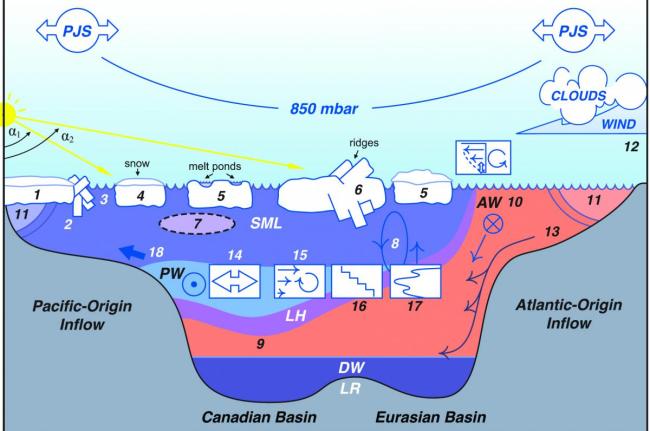Role of Oceanic Heat in Sea Ice Loss in the New Arctic
The retreat and thinning of the summer sea ice are the most visible indicators of the major physical changes underway in the Arctic Ocean. While rates and even causes of ice loss remain under debate, further loss of sea ice will open the ocean to stronger atmospheric forcing and accelerate ongoing feedback processes. Recent observations and model results suggest that small changes in the ways that the ocean transports heat – originating from the seasonal cycle of surface fluxes and advective inputs from the sub-Arctic oceans and rivers – to the overlying ice cover could have a substantial impact on current and future changes in Arctic ice cover. Advances in our understanding and synthesis of complex ocean–ice–air interactions and associated feedbacks on broad time (minutes to interannual) and space (millimeters to global) scales are required to provide realistic projections of the fate of seasonal and perennial sea ice in the Arctic Ocean in the coming years and decades. With continued decline in sea ice cover, and enhanced coupling of the atmosphere to the ocean, the physical processes controlling the delivery, storage, and release of heat within the Arctic Ocean to the ice cover are likely to increase in importance and must be understood if we are to reduce uncertainties in projections of the Arctic’s likely linkages to weather and plausible trajectories of future climate. A new paper by Carmack et al. (2016) identifies the critical processes, key questions, and required elements for a research agenda that combines field-based process studies, sustained observational programs, and modeling. Because physical systems within the Arctic Ocean impact biogeochemical processes and occur across sovereign state boundaries, true multidisciplinary, multiagency, and multinational efforts are emphasized.

Toward Quantifying the Increasing Role of Oceanic Heat in Sea Ice Loss in the New Arctic (Bulletin of the American Meteorological Society)
1Fisheries and Oceans Canada
2University of Alaska, Fairbanks
3Earth and Space Research
4University of Bergen
5Los Alamos National Laboratory
6Oregon State University
7Hakai Institute, Canada
8Dalhousie University, Canada
9Jet Propulsion Lab, California Institute of Technology
10Cold Regions Research and Engineering Laboratory
11University of Colorado, Boulder
12Yale University
13Woods Hole Oceanographic Institution
14University of Wisconsin, Madison
Topics
- Sea Ice
- Climate Change
- Arctic
- Ecosystem Impacts
